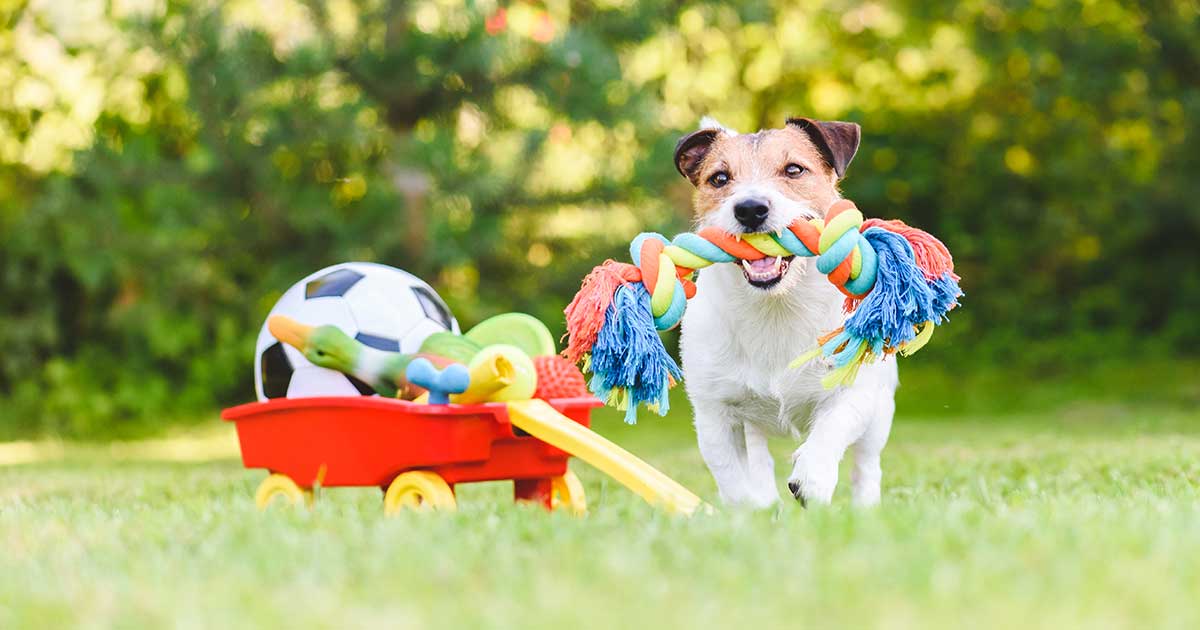True Cellular Formulas Team - April 05, 2024
Choosing Non-Toxic Dog Toys
A Guide to Safer Playtimes

In the world of pet ownership, the safety and well-being of our furry companions are paramount. Yet, amidst the joy of watching them play, there lurks an often-overlooked danger: the toxic chemicals present in many name-brand dog toys. These toys, though colorful and enticing, may harbor a cocktail of harmful substances, from BPA to lead, posing unseen risks to our pets. This guide delves into the significance of selecting non-toxic alternatives, ensuring our dogs can play safely and happily.
The Risks of Toxic Dog Toys
The reality that many dog toys contain toxic chemicals is both surprising and concerning for pet owners. Popular toys, including those brightly colored balls and chewables, often come with a hidden cost to health due to their synthetic material composition. BPA (Bisphenol A) and lead, specifically, are notorious for their potential to disrupt endocrine functions and cause neurological damage, respectively.[1] The risk these chemicals pose is not negligible; chronic exposure, even in small amounts, can lead to serious health issues over time. Research in veterinary science suggests a correlation between exposure to these toxins and various health problems in dogs, including hormonal imbalances and behavioral issues.[2] By understanding these risks, pet owners can make informed decisions about which toys to welcome into their homes.
Identifying Safe Materials and Non-Toxic Alternatives
Navigating the world of dog toys doesn't have to be a minefield. The key is knowing which materials are safe and which to avoid. Among the safest materials for dog toys is 100% natural rubber. Unlike its synthetic counterparts, natural rubber does not release harmful chemicals. Moreover, toys made from this material are often more durable and provide a healthier chewing experience for dogs. When choosing natural rubber toys, it’s crucial for pet owners to look for products that have been rigorously tested for toxic chemicals. This extra step ensures the toys are not only non-toxic but also safe for our pets to chew on daily.
Transitioning to safer chew toys doesn't mean compromising on fun. Real deer or elk antlers present a wonderful alternative for dogs who love to chew. These natural options offer more than just a chewing experience; they're packed with micronutrients and provide a source of protein. However, it's important to select antlers that are appropriate for your dog's size and chewing habits. While these natural chews reduce the risk of splintering—a common hazard with traditional bones—they're not suitable for all dogs. Owners of particularly vigorous chewers should monitor their pets to prevent any potential for dental damage.
Safe Alternatives to Backyard Sticks
While the image of a dog happily trotting along with a stick in its mouth is iconic, the reality is that backyard sticks can pose significant risks to our pets. From splintering that can lead to internal injuries to the risk of choking on broken pieces, the dangers are real. Thankfully, there are safer alternatives that allow dogs to indulge in their natural instincts without the associated risks. Products like JavaWood and Heath Tree roots are excellent examples. These are specifically designed to be durable and splinter-resistant, offering a safer chewing experience. Made from naturally hard woods, these alternatives do not just mimic the texture of real sticks but are also less likely to break into dangerous shards. Choosing these safer options means pet owners can rest easier, knowing their dogs can enjoy a good chew or fetch session without the potential for harm.
Beyond Chew Toys: A Holistic Approach to Non-Toxic Play
Ensuring the safety of our pets extends beyond just chew toys. It encompasses everything from the squeaky toys that keep them entertained to the beds they sleep on at night. To truly protect our pets, it's important to adopt a holistic view of their environment. This means opting for toys that are free from toxic dyes and glues, as well as being environmentally sustainable. Many companies now offer a wide range of non-toxic pet toys made from organic cotton, recycled materials, and natural dyes. These options not only safeguard the health of our pets but also contribute to the well-being of our planet. When selecting toys, look for certifications and labels that guarantee the product's safety and environmental friendliness. By making conscious choices, pet owners can ensure their beloved companions enjoy a fun, safe, and healthy playtime.
Summary
The journey towards a toxin-free play environment for our pets requires vigilance, education, and a commitment to making informed choices. By understanding the risks associated with toxic dog toys and knowing how to identify safer alternatives, pet owners can significantly enhance the quality of life for their furry family members. Remember, the joy and well-being of our pets are intertwined with the decisions we make on their behalf. Let's choose wisely, ensuring our dogs have access to toys that are not only entertaining but also safe and healthy.
- Wooten, Kimberly J, and Philip N Smith. “Canine toys and training devices as sources of exposure to phthalates and bisphenol A: quantitation of chemicals in leachate and in vitro screening for endocrine activity.” Chemosphere vol. 93,10 (2013): 2245-53. doi:10.1016/j.chemosphere.2013.07.075
- Pocar, Paola et al. “Endocrine-Disrupting Chemicals and Their Effects in Pet Dogs and Cats: An Overview.” Animals : an open access journal from MDPI vol. 13,3 378. 22 Jan. 2023, doi:10.3390/ani13030378



